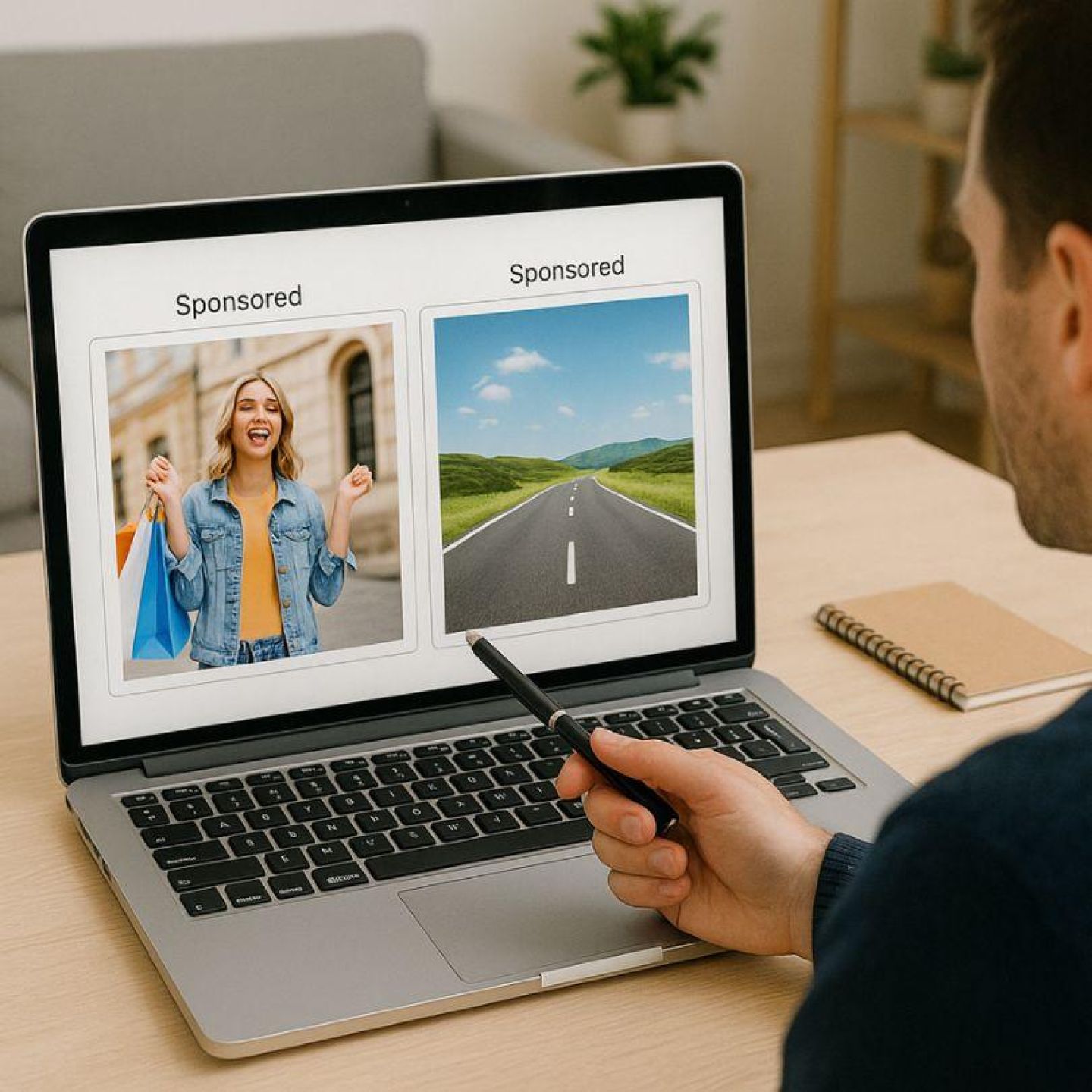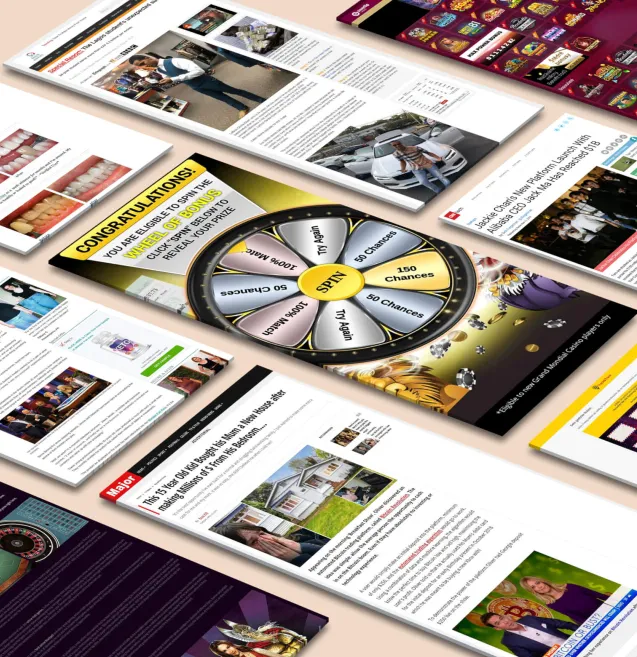
Наши инструменты отслеживают миллионы рекламных кампаний в форматах native, push, pop и TikTok.
НачатьКреативный ротейтинг в нативной рекламе — это практика регулярного обновления и изменения визуальных элементов, сообщений и форматов вашей рекламы, чтобы поддерживать интерес аудитории. Это похоже на обновление дизайна ваших кампаний до того, как аудитория полностью потеряет к ним интерес.
Вот в чем дело: когда вы показываете одну и ту же рекламу одному и тому же кругу людей снова и снова, они перестают обращать на нее внимание. В результате ваши клики падают, расходы растут, а эффективность кампаний снижается. Это явление — усталость от рекламы в нативной рекламе — незаметно разрушает в противном случае успешные кампании.
Решение? Стратегическое расписание обновления визуальных элементов нативной рекламы, которое гарантирует, что ваш контент всегда будет ощущаться как новый и актуальный. Вы меняете изображения не ради самих изменений; вы активно не допускаете, чтобы ваша аудитория перестала замечать ваше сообщение.
Усталость от рекламы в нативной рекламе возникает, когда ваша аудитория многократно видит одни и те же креативные элементы, в результате чего она мысленно перестаёт воспринимать ваше сообщение. Вы заметите это явление по снижению измеримых показателей эффективности, которые напрямую влияют на прибыльность вашей кампании.
Предупреждающие признаки очевидны. Сначала появляется снижение CTR — платформы, такие как Meta, сообщают о среднем падении на 17% всего за шесть дней непрерывного показа одинаковых креативов. За этим вскоре следует рост стоимости привлечения клиента (CPA), поскольку вам приходится тратить больше для достижения прежнего результата. Признаки снижения вовлечённости пользователей становятся очевидными: падает уровень вовлечённости, становится меньше комментариев и сокращается время просмотра вашего контента.
Обращайте внимание на следующие конкретные индикаторы в вашей стратегии эффективности нативной рекламы:
Эти метрики работают как система раннего оповещения, сигнализируя о том, что ваши рекламные материалы необходимо обновить.
Ротация креативов — это ваша основная защита от снижения эффективности кампании. Применяя стратегию ротации креативов для нативной рекламы, вы фактически нарушаете шаблон, из-за которого аудитория перестаёт замечать ваши объявления. Каждый раз, когда вы добавляете новое визуальное решение, заголовок или формат, вы сбрасываете «часы внимания» и вновь вовлекаете пользователей, которые уже пролистывали ваш контент мимо.
Механизм этой стратегии основан на психологической новизне. Мозг естественным образом реагирует на новые элементы, поэтому смена 3–5 креативных вариантов в рамках одной кампании позволяет поддерживать стабильную частоту кликов (CTR) на таких платформах, как Meta. Без ротации уровень CTR обычно падает на 17% уже через неделю. В TikTok, где контент потребляется ещё быстрее, обновление рекламных материалов каждую неделю показало рост конверсий на 23% по сравнению со статичными кампаниями.
Оптимизация креативов для нативной рекламы — это больше, чем просто смена картинок. Ниже приведены дополнительные элементы, которые можно тестировать:
Стратегия ротации креативов для нативной рекламы становится ещё эффективнее при сочетании с другими тактиками:
Эти дополнительные тактики создают несколько уровней защиты от насыщения, обеспечивая доставку вашего сообщения пользователям с оптимальной периодичностью на всех возможных точках контакта.
Вам нужен системный подход, чтобы ваши нативные объявления работали на пике эффективности. Календарь ротации креативов для нативной рекламы служит вашим руководством по поддержанию свежего, интересного контента, который находит отклик у аудитории, не перегружая ее.
Начните с планирования графика ротации на основе целей вашей кампании и данных, специфичных для платформы. Если вы запускаете кампании в Meta, обновляйте контент каждые 5–7 дней, поскольку CTR, как правило, снижается на 17% после шести дней. TikTok требует еще более быстрых циклов — вам нужно менять креативы каждые 3–5 дней, чтобы соответствовать скоростному потреблению контента на платформе.
Нельзя преуменьшать значение нескольких вариантов объявлений для непрерывного тестирования. Вы должны поддерживать не менее 3–5 активных вариантов на каждый набор объявлений в качестве базового уровня, хотя высокорезультативные кампании зачастую выигрывают от наличия 10–15 версий, готовых к публикации. Такой подход позволяет вам:
Каждый вариант должен существенно отличаться — меняйте заголовок, основное изображение, призыв к действию или полностью модифицируйте формат. Небольшие изменения имеют значение, когда вы боретесь с рекламным утомлением.
Правильная частота обновления рекламы для нативной рекламы имеет решающее значение между стабильной эффективностью и потраченным впустую бюджетом. Данные отрасли показывают, что еженедельные или раз в две недели циклы обновления работают лучше всего на большинстве платформ, хотя это значительно варьируется в зависимости от места размещения рекламы.
Усталость от креативов возникает, когда ваша целевая аудитория слишком часто сталкивается с одной и той же рекламой, в результате чего снижается вовлеченность и эффективность. Крайне важно понимать, как различные платформы реагируют на усталость от креативов, чтобы соответствующим образом планировать стратегию их обновления.
Для кампаний, запущенных в Meta (Facebook и Instagram), исследования показывают, что усталость от креативов обычно наступает в течение 5–7 дней. Это означает, что после шести дней постоянного показа можно ожидать снижения CTR (частоты кликов) примерно на 17%. Чтобы предотвратить это снижение и поддерживать оптимальную производительность, рекомендуется осуществлять еженедельное обновление креативов на этих платформах.
TikTok работает еще быстрее, чем Meta. Исследования показали, что кампании с еженедельным циклом замены креативов в TikTok приносят до 23% больше конверсий, по сравнению с неизменными креативами. Это в первую очередь связано с тем, что алгоритм платформы отдает предпочтение новому контенту по сравнению с повторяющейся рекламой. Поэтому, если вы размещаете рекламу в TikTok, обязательно планируйте частое обновление креативов, чтобы опережать снижение результативности.
Своевременное выявление признаков усталости от рекламы имеет важное значение для предотвращения серьезного падения результативности. Обратите внимание на следующие предупреждающие сигналы:
Хотя важно внимательно отслеживать эти признаки усталости, вы не всегда должны ждать полного провала показателей, прежде чем предпринимать действия. Настройка автоматических оповещений поможет вам действовать заблаговременно при управлении кампаниями.
Рекомендуем настраивать оповещения при:
Получая своевременные уведомления об этих изменениях, вы сможете использовать новые креативы до того, как кампания потеряет свою эффективность. Такой превентивный подход поможет не только сохранять стабильные результаты, но и контролировать расходы, избегая ненужных трат на неэффективные объявления.
Управление творческими ротациями вручную становится невыполнимой задачей по мере расширения ваших кампаний на нескольких платформах и сегментах аудитории. Инструменты автоматизации для управления рекламой превращают этот сложный процесс в упрощённую операцию, которая экономит вам часы ежедневной работы.
Платформы, такие как Meta Ads Manager, TikTok Creative Center и сторонние инструменты, например Revealbot или Smartly.io, предлагают такие возможности. Это значит, что вы можете легко интегрировать автоматизацию в уже существующий рабочий процесс и начать получать преимущества.
Настоящее преимущество заключается в прогнозной оптимизации. Продвинутые алгоритмы определяют, какие элементы креативов наиболее эффективны для определённых сегментов аудитории, автоматически распределяя бюджет в пользу лучших вариантов и постепенно исключая слабые. Такой подход, основанный на данных, исключает догадки из вашей стратегии ротации и позволяет сосредоточиться на создании качественных креативов, а не на микроменеджменте кампаний.
Вам необходимы конкретные данные, чтобы проверить, работает ли ваша стратегия ротации креативов. Начните с установления базовых показателей до внедрения графика ротации, а затем отслеживайте следующие KPI для измерения эффективности стратегии ротации креативов:
Внедрение стратегии обновления креативов необходимо, чтобы поддерживать актуальность, своевременность и релевантность вашего сообщения — ключевые факторы успеха кампании.
Обновление нативной рекламы имеет решающее значение для долгосрочного успеха кампании. Речь идет не только о предотвращении усталости от рекламы, но и о создании устойчивой стратегии рекламы, которая уважает внимание вашей аудитории и максимизирует ваши маркетинговые инвестиции.
Данные говорят сами за себя: платформы вроде Meta показывают снижение CTR на 17% в течение шести дней без обновления, в то время как кампании в TikTok с еженедельной сменой достигают на 23% больше конверсий. Эти цифры доказывают, что систематическая смена объявлений напрямую влияет на вашу прибыль. Начните сегодня составлять календарь смены креативов, подготовьте несколько вариантов для тестирования и не забывайте отслеживать ранние предупреждающие сигналы. Ваши кампании и ваша аудитория будут вам благодарны.
Получайте лучшие конверсионные лендинги каждую неделю на свою почту.
Инструкция
Нативная реклама способна делать нечто большее, чем просто увеличивать количество кликов — она может укреплять долгосрочную лояльность к бренду. Узнайте, как использовать искреннее сторителлинг, стратегическое размещение и таргетирование аудитории, чтобы усилить доверие в кампаниях под конец года. Выясните, как ненавязчивые сообщения, основанные на ценностях, удерживают клиентов после праздников. Идеально подходит для маркетологов, стремящихся превратить сезонных покупателей в преданных сторонников бренда.
Marcus Chen
7 миндек. 15, 2025
Недавно обновлено
Нативная реклама может определить успех или неудачу вашей маркетинговой кампании в праздничный сезон. Узнайте, как оценить недавние кампании и выявить то, что сработало — или что оказалось неэффективным — в нативной рекламе. Освойте ключевые тактики оптимизации, чтобы повысить вовлеченность, укрепить доверие аудитории и увеличить конверсии в будущих промоакциях. Идеально подходит для маркетологов, стремящихся усовершенствовать свои рекламные стратегии после новогодних хлопот.
Elena Morales
7 миндек. 1, 2025
Коротко
После Черной пятницы покупатели хотят большего, чем просто скидки, — им нужны общение и смысл. Узнайте, как креативное сторителлинг может превратить постпродажные кампании в мощные драйверы конверсии. Научитесь создавать нарративы, которые укрепляют доверие, усиливают лояльность к бренду и вдохновляют на действия, выходящие за рамки скидок. Идеально подходит для маркетологов, стремящихся поддерживать высокую вовлеченность еще долго после окончания ажиотажа вокруг распродаж.
Marcus Chen
7 миннояб. 29, 2025




